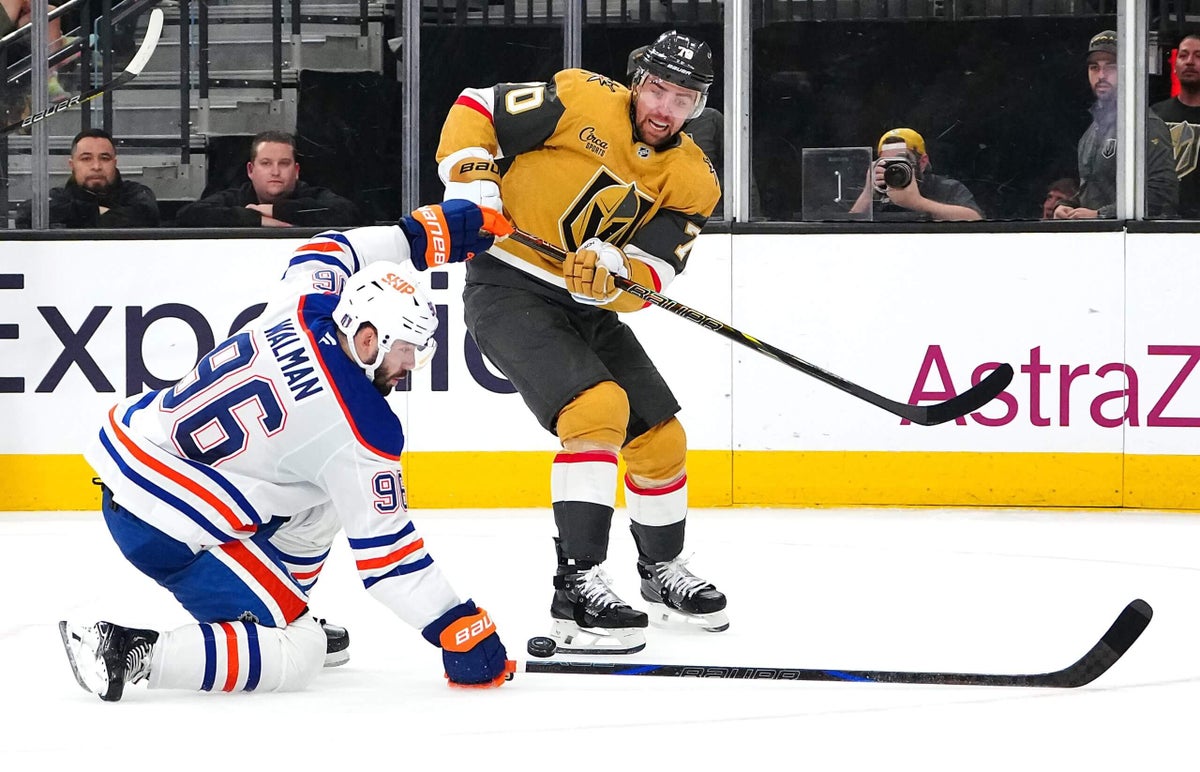

Stan Bowman gave fans a clear indication of his preferences on defence at the 2025 deadline. A team that many felt lacked toughness on the blue line eschewed an enforcer and acquired a skilled veteran (Jake Walman) with plus speed and the ability to move the puck with aplomb.
Why would the Oilers acquire another left-handed defenceman whose skill set was already duplicated on the roster? It turned out that it was key to the team’s playoff game plan. Bowman’s Oilers are a club that features defencemen who can bring three specific things. Here they are.
Advertisement
Speed
How fast is Edmonton’s defence? NHL Edge tells us the collective members of the Oilers have a top skating speed in the 99th percentile during this spring’s playoffs. How fast are the individual defencemen for this year’s team? Fast.
| Player | Top Speed (KPH) | Percentile |
|---|---|---|
|
34.88 |
82 |
|
|
34.81 |
81 |
|
|
34.4 |
75 |
|
|
34.21 |
69 |
|
|
33.4 |
Below 50 |
|
|
32.28 |
Below 50 |
|
|
28.92 |
Below 50 |
All numbers KPH, via NHL.com
Edmonton’s four fastest defencemen in this series are top flight, with John Klingberg coming in just a hair below average (average was 33.55 KPH through the first round). Mattias Ekholm, Edmonton’s top-pairing defender who is currently injured, ran a 34.72 KPH during the regular season.
Vegas as a team (including all skaters) boasts a 36.44 kph top skating speed, landing below NHL average. The Oilers should have the speed edge throughout this series.
Passing
This version of the Oilers coaching staff asks a lot of their defenders. One of the keys is puck retrieval on opposition dump-ins. This group has the boots to make it happen, but that’s just one element. The Edmonton defencemen must race back to the puck, send it to a teammate (mostly like the defensive partner) who then sends a deft pass to a forward for transportation.
The team adjusts at times with the forwards coming all the way down into the zone, but most of the assignment belongs to the defence.
In the Los Angeles series, the Oilers made shorter passes (fewer stretch passes), and fans saw much the same in the first tilt versus Vegas.
Given time and space, the outlet pass gave way to a handoff from defence to forward during the Kings series. Vegas is more aggressive, and the passive option wasn’t as available as often in the first game against the Golden Knights.
Execution
During the Los Angeles series, Evan Bouchard averaged 29.5 shifts per game in all three disciplines (even strength, power play and penalty kill). averaging 52 seconds per shift. The time-on-ice breakdown for the puck-moving defenceman in the first round is revealing.
Advertisement
His even-strength TOI per game (21:28) was an increase from the regular season (20:11); his power-play ice time in the postseason (2:52) is down from 3:19 during the regular season. That’s a small difference considering the random nature of power-play opportunities over a six-game series. The interesting tweak in Bouchard’s TOI comes while short-handed. He’s averaging 1:21 per game in the playoffs, after playing just 14 seconds per game during the regular season.
Bouchard played some unique minutes versus the Kings and we could see this trend continue in the playoffs.
Walman-Klingberg
In the Los Angeles series, the Nurse-Bouchard pairing struggled at times. Through the six games of Round 1, the tandem played 58 minutes together and delivered a 30 percent goal share. That’s poor, despite the expected goal share (52 percent) suggesting that regression is near.
Kris Knoblauch didn’t check down from the pairing by deploying Walman. Rather, he used Brett Kulak with both Nurse and Bouchard in an effort to calm the waters. It worked with Bouchard, not so much with Nurse.
Knoblauch and his coaching staff gave plenty of playing time to the tandem of Walman and Klingberg at five-on-five against Los Angeles. In 55 minutes at five-on-five, the duo helped outscore opponents 3-0 and enjoyed great success in the discipline.
Walman spent significant time away (50 minutes, 4-3 goals) and much of that with Bouchard (3-2 goals together at five-on-five in 29 minutes).
As the series against Vegas progresses, it’s possible that Klingberg’s coverage issues drag the team’s five-on-five outscoring. We could see a shuffle in the top pairing, with Walman-Bouchard taking centre stage at that time.
Many observers believe that’s the ideal top pairing until Ekholm returns.
Kulak
One of the keys to what was a unique approach in the first round was made possible by Kulak’s impressive skill set. A fast train who can recover, slide into an offensive opportunity and close a gap quickly, Kulak’s ability to play left or right side defence was another important factor against Los Angeles.
Advertisement
At five-on-five, Kulak played 124 minutes in the first round, helping Edmonton outscore the Kings 5-3 with an expected goal share of 64 percent. He played 40 minutes with Ty Emberson, 32 minutes with Nurse, 29 minutes with Bouchard and the rest with various partners. His utility is a major story for Edmonton this spring.
Viva Las Vegas
Game 1 of the second round featured early chaos for the Oilers, with loose play and turnovers on the double. The suffocating Vegas forecheck caused turnovers and early on a seasoned Oilers fan might have experienced a blast from the past with a couple of Kris Russell-level desperation exit attempts.
By the end of the period, the defencemen reset and the Edmonton formation behind its own blue line looked more structured and under control. Vegas contests every puck beginning at the start of the anthem, so turnovers in ghastly places are more common than any hockey coach on the planet would endorse.
That said, with the understanding that the Oilers employ no shutdown defenders, much of the game involved an Oilers defenceman on the scene of possible accidents with great regularity.
The Nurse-Bouchard pairing went 1-0 goals and 7-1 shots in the first period, but it was another defensive pairing that was responsible for the genesis of Edmonton’s first goal of the series. Deep in the Oilers’ zone, Kulak made a nice defensive play, Klingberg sent a lovely pass across ice through the neutral zone, and that duo went to the bench. By the time Corey Perry scored, it was Nurse and Bouchard on the ice and credited with a plus on the play. Emberson was impressive with several fine defensive plays, which stood out in a first period that was less than ideal for nervous Oilers fans.
The second period was impressive by the Oilers’ blue line. Great passing, coverage defensively and smart plays all over the ice. Example: Walman blocking a pass on a two-on-one that looked like a sure goal.
The third period was classic NHL play, something close to a heavyweight boxing match that went 15 rounds. This is going to be a helluva series.
The Oilers defence held, and delivered a solid performance.
(Photo of Jake Walman and Tanner Pearson: Stephen R. Sylvanie / Imagn Images)
This news was originally published on this post .










Be the first to leave a comment